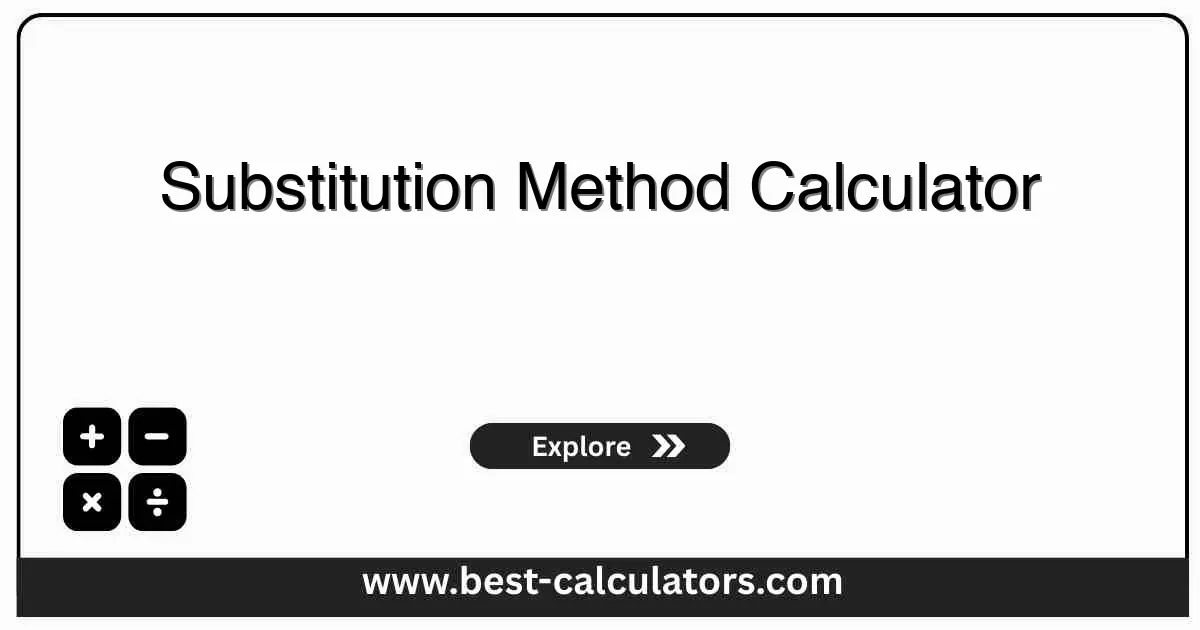Substitution Method Calculator - Solve 2x2 Systems
Free calculator to solve systems of equations using substitution method. Get step-by-step solutions with detailed substitution steps
Substitution Method Calculator
Solution
Common Examples
What is a Substitution Method Calculator?
A substitution method calculator is a mathematical tool that solves systems of linear equations by isolating one variable in one equation and substituting its expression into the other equation. This transforms a two-variable system into a single-variable equation that can be solved directly, then back-substitutes to find the second variable.
The substitution method is one of three fundamental algebraic approaches for solving linear systems, complementing elimination and graphing methods. It's particularly valuable in applications including business optimization problems, physics trajectory calculations, chemistry mixture problems, and economics supply-demand equilibrium analysis where isolating variables provides meaningful interpretations.
This calculator demonstrates the substitution process step-by-step, showing how to express one variable in terms of another and substitute this expression to eliminate variables systematically. It handles all solution scenarios including unique solutions, parallel lines with no solution, and coincident lines with infinitely many solutions, providing complete system analysis.
For alternative methods, try our elimination method calculator and general system of equations calculator. The quadratic formula calculator solves quadratics. For percentages, use our percentage calculator.
How the Substitution Method Calculator Works
The calculator identifies which variable is easiest to isolate by examining coefficients. It prefers variables with coefficient 1 or -1 for simplest isolation. From equation ax + by = c, it solves for one variable: if isolating x, then x = (c - by)/a. If isolating y, then y = (c - ax)/b.
This expression is substituted into the second equation, replacing the isolated variable everywhere it appears. For example, if x = (c - by)/a is substituted into dx + ey = f, it becomes d[(c - by)/a] + ey = f. Simplifying this single-variable equation yields the value of y.
Once one variable is known, the calculator substitutes this value back into the expression for the other variable to find its value. It verifies the solution by checking both values in both original equations. The determinant ae - bd indicates solution type: non-zero means unique solution, zero with consistency means infinite solutions, zero with inconsistency means no solution.
Key Concepts Explained
Variable Isolation
Solving one equation for a single variable in terms of others. For x + 2y = 7, isolating x gives x = 7 - 2y. This expression replaces x elsewhere.
Substitution Process
Replacing a variable with its expression from another equation. If x = 7 - 2y, substitute this into 3x - y = 4 to get 3(7 - 2y) - y = 4.
Back-Substitution
After finding one variable, substitute its value into the expression for the other. If y = 2.43, then x = 7 - 2(2.43) = 2.14.
Solution Verification
Checking solutions by substituting both values into both original equations. If both equations are satisfied, solution is correct.
How to Use This Calculator
Enter First Equation
Input coefficients a, b, c for first equation ax + by = c in standard form
Enter Second Equation
Input coefficients d, e, f for second equation dx + ey = f in standard form
Solve System
Click Solve to use substitution method and get instant solution with both variable values
View Solution
See x and y values plus solution type (unique, no solution, or infinite solutions)
Benefits of Using This Calculator
Using this substitution method calculator streamlines multi-step algebraic processes and prevents errors in fraction arithmetic and distribution that commonly occur in manual substitution.
Instant Solutions: Get results immediately instead of working through substitution steps manually
Avoid Errors: Eliminate mistakes in algebraic manipulation, distribution, and fraction operations
Learn Method: Understand substitution process by seeing complete solution steps and logic
Verify Homework: Check your manual substitution work for accuracy before submission
Identify Solution Types: Automatically detect unique, no solution, or infinite solution cases
Factors That Affect Your Results
The coefficients and constants you enter determine solution existence and values. Understanding these patterns helps predict system behavior and choose efficient solution strategies.
Coefficient Simplicity
Variables with coefficient 1 or -1 are easiest to isolate. When available, choose these for substitution to minimize fraction arithmetic and algebraic complexity.
Fraction Complexity
Isolating variables with larger coefficients creates fractions. For example, from 3x + 2y = 7, solving for x gives x = (7 - 2y)/3, introducing fractions throughout.
Method Choice
Substitution works best when isolation is simple. When coefficients make isolation difficult, elimination method may be more efficient. Both give identical solutions.

Frequently Asked Questions (FAQ)
Q: What is the substitution method?
A: The substitution method is a technique for solving systems of equations by solving one equation for a variable, then substituting that expression into the other equation. This reduces the system to a single equation with one variable.
Q: When should you use substitution method?
A: Use substitution when one equation already has a variable isolated or can be easily isolated, when coefficients make elimination difficult, or when dealing with non-linear systems. It's ideal when one variable has coefficient 1 or -1.
Q: How do you choose which variable to solve for?
A: Choose the variable with coefficient 1 or -1 for easiest isolation. Look for variables already isolated or requiring minimal manipulation. Either variable works mathematically, but one choice typically requires simpler algebra.
Q: What if substitution gives a false statement?
A: If substitution yields a false statement like 0 = 5, the system is inconsistent with no solution (parallel lines). If it yields a true statement like 0 = 0, the system is dependent with infinitely many solutions (same line).
Q: Is substitution or elimination better?
A: Neither is universally better - choose based on the system. Use substitution when a variable is easily isolated. Use elimination when coefficients are convenient multiples. Both methods give the same answer for any solvable system.